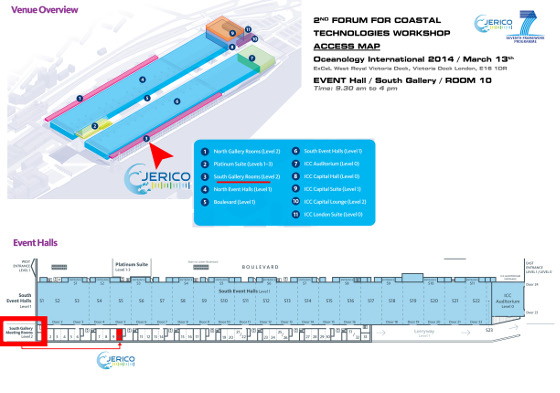Date
13/03/2014
‘Dissolved Oxygen calibration / What are the best procedures?’
An interactive workshop to identify the best practices about dissolved oxygen calibration procedure
Context:
The first FCT JERICO workshop was organized in October 2012 at the Sea Tech Week (France). It gave the opportunity for both scientists and company’s representatives to discuss about needs from in the field of in-situ sampling and monitoring. The workshop focused on dissolved oxygen (DO) and nutrient. Shortly after this meeting, a white paper on DO was written (Laurent Coppola et al.). This document reminds the key role of DO in biogeochemical cycles, emphasizing the scientific needs (accuracy, reliability, robustness), but also particularly highlight the huge difficulties to calibrate the sensors (mainly optodes in green water).
Indeed, DO sensor’s calibration and maintenance is a time consuming and costly operation that is affordable mostly in large public research institutes. Very often, scientists do calibration for their own applications. But they, as well as companies and other users (coastal environmental activities for regulation or management), need to be informed of the best calibration practices.
In this context, a guide on best practices to calibrate oxygen sensor will be a valuable document for both users and manufacturers. OI 2014 occurs in March 2014 gathering most of the oceanographic institutes, sensor manufacturers and users. Beside this event, JERICO is therefore organizing its second FCT workshop. This workshop will provide the opportunity for attendees to share their experiences and discuss their methodologies to calibrate DO sensors. The main goal is to collect information in order to write recommendations on best practices.
This one-day workshop will be divided in two sessions:
During the morning, participants will share their knowledge with presentations of their calibration protocols. Reference laboratories will give experience and information in the domain of certification and ETV schemes. Companies and sensors users (from surveillance monitoring) will present their experience and needs for their ‘routine’ activities.
The afternoon will be moderate around 4 or 5 main questions and topics (calibration, maintenance, long term in-situ stability, calibration market, organization, cost, know how), in order to get information and data to harmonize and improve the calibration procedures.
This workshop is opened to scientists and users of DO sensors that are waiting for improvements, whatever the technology of their instruments. Manufacturers and sensor dealers are particularly welcome to attend and participate to discussions. It is an opportunity to (1) explore deficiencies in the current state-of-the-art of calibration procedures, (2) consider the potential for advances in calibrations procedures, (3) Identify the major challenges to apply best practices. It is anticipated that a synthetic document on recommendations and best practices protocols will emerge from the discussion.
Agenda:
|
|
Item |
Speaker |
|
9:30 |
Welcome and Introduction |
Glenn Nolan Marine Institute (Ireland) |
|
9:50– 12:30 |
Session One – Presentations |
|
|
9:50 |
Scientist focus Calibration needs, current practices and alternatives |
Florence Salvetat, IFREMER (France) |
|
10:10 |
Certification organism focus Performances of continuous and portable measuring devices: standardization, certification or ETV verification? |
Nathalie Guigues, Lab. National de Métrologie et d’Essais (France) |
|
10:30 |
Scientist focus Feedback on oxygen sensor calibrations (AADI’s oxygen optodes, JFE’s RINKO) and long-term stability in FerryBox systems |
W Petersen HZG – Helmholtz-Zentrum Geesthacht (Germany) |
|
10:50 |
Scientist focus Oxygen measurements in oceanography: sensors accuracy and scientific needs |
Laurent Coppola Obs. de Villefranche-sur-Mer / CNRS-UPMC (France) |
|
11:10 |
Manufacturer focus Improve your oxygen optode measurements – user examples, practical handling and calibrations |
Anders Tengberg, Aanderaa (Norway) |
|
11:30
|
Manufacturer focus Fast response DO sensor – RINKO |
Hua Li JFE Advantech Co., Ltd (Japan) |
|
11:50 |
Manufacturer focus Monitoring Dissolved Oxygen: Best Practices, Calibration, and Validation |
Carol Janzen Sea-Bird Electronics (USA) |
|
12:10
|
Manufacturer focus Views and experience on the implementation of dissolved oxygen calibration at NKE instrumentation |
Damien Malardé NKE Electronics (France) |
|
|
Break (lunch) |
|
|
14 – 16 |
Session Two |
|
|
14:00 |
Facilitated Discussion Topic #1: Adapted calibration (coastal or open sea) and the essential calibration steps (good practices)
Topic #2: Calibration Market (low cost sensors, training, certification, QC…)
Topic #3: Main ‘field’ vs lab issues
Restitution and synthesis |
Chaired by: Yannick Aoustin IFREMER (France)
(Audience might be divided in three groups) |
|
16:00 |
Summary & close |
Patrick Farcy (Coordinator) IFREMER (France) |
Date: Thursday 13th March 2014 9am – 5pm
Venue: ExCel Exhibition Centre, Royal Victoria Dock, 1 Western Gateway, London, E16 1XL
Access map:

Registration and information: philippe.monbet@pole-mer-bretagne.com
 FCT OI 2014 Agenda PM-3 Nolist (2.3 MiB)
FCT OI 2014 Agenda PM-3 Nolist (2.3 MiB)
Location
ExCel Exhibition Centre, Royal Victoria Dock, 1 Western Gateway, London, E16 1XL
